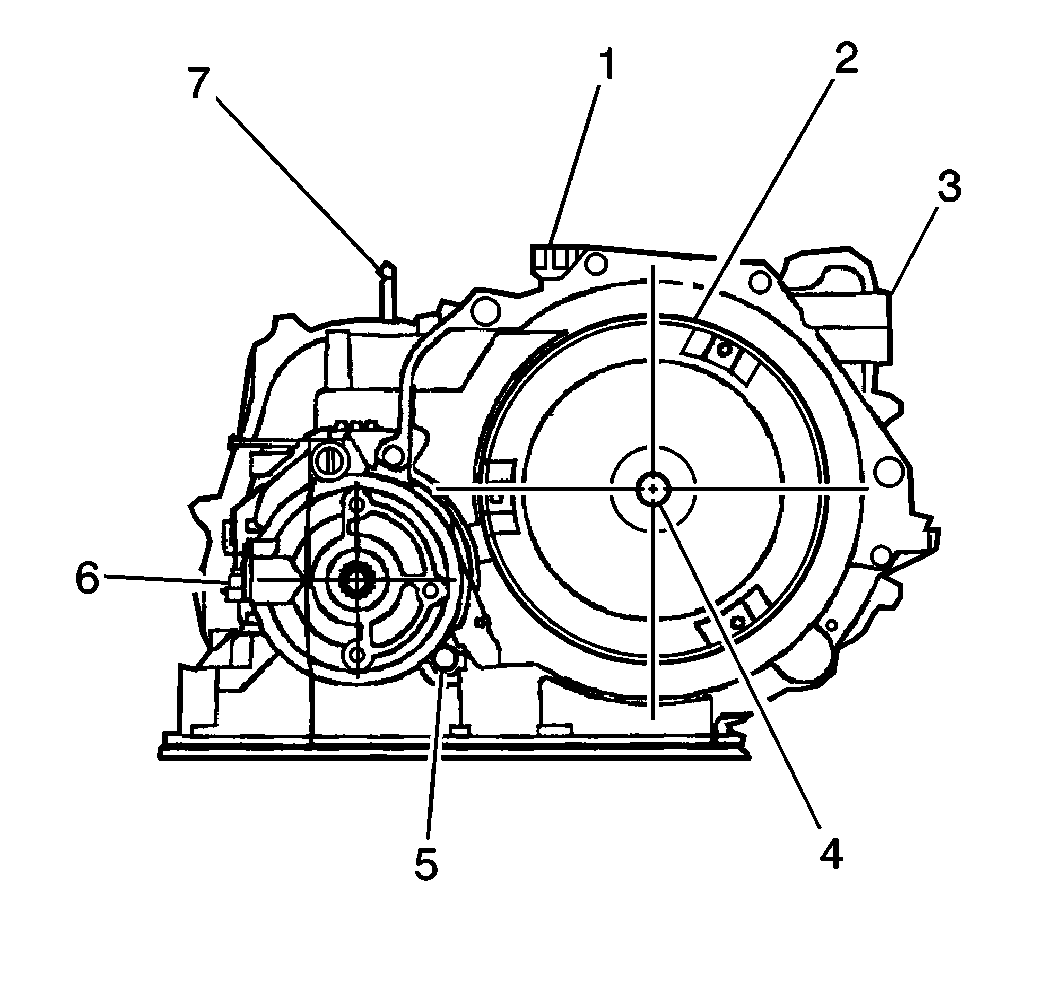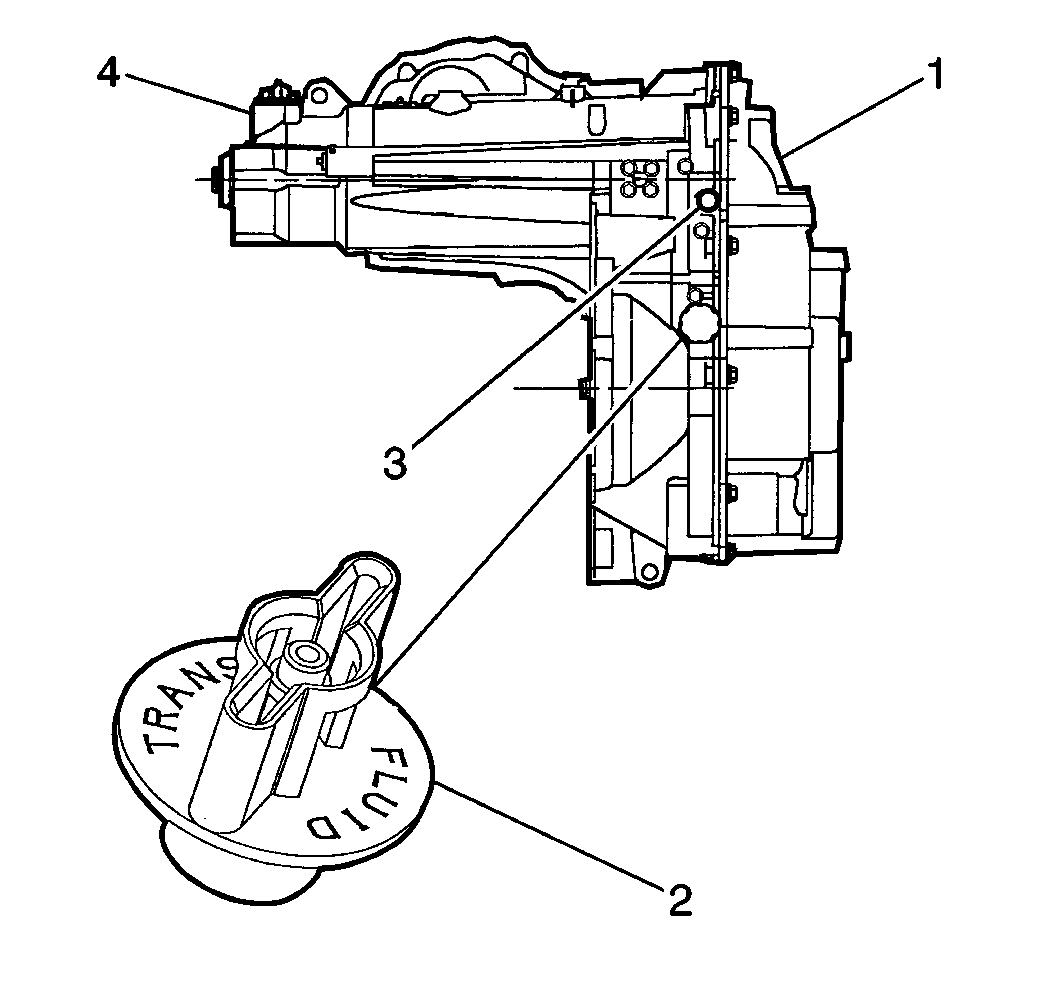Transmission Fluid Check Preliminary Check
The condition of an automatic transmission not operating properly may be influenced by one, or a combination of the following items:
| • | High or low oil level |
| • | Engine performance. Refer to Engine Mechanical or Engine Controls. |
| • | TV cable adjustment |
| • | Manual linkage adjustment |
| • | Internal oil leaks. Refer to Automatic Transmission or Transmission/Transfer Case Unit Repair Manual. |
| • | Electrical System. Refer to Engine Controls or Electrical Diagnosis. |
| • | Transmission or other mechanical component. Refer to Automatic Transmission or Transfer Case Unit Repair Manual. |
| • | Temperature |
Transmission Fluid Check Oil Level Check
Inspection Procedure

Use the fluid level screw (5) for diagnosing a transmission fluid leak or for resetting the transmission fluid level after the service that involves a loss of fluid.
For inspecting the oil color, level and condition, refer to Transmission Fluid Check .
- Inspect the fluid level when the transmission is near room temperature or at 40°C (104°F).
- Be sure the engine is running.
- Raise the vehicle on a hoist. Refer to General Information.
- Place the oil container under the check plug.
- Remove the oil check plug.
- Ensure that the oil level is at the bottom of the oil check hole. Because the transmission operates correctly over a range of fluid levels, the fluid may or may not drain out of the screw hole after removing the screw.
Caution: Removal of the fluid level screw when the transaxle fluid is hot may cause injury. Use care to avoid contact of transaxle fluid to exhaust pipe.
Adding Transmission Oil

If the fluid drains through the screw hole the transmission may have been overfilled. When the fluid stops draining the fluid level is correct, and you may install the check plug. If the fluid does not drain through the screw hole, the transmission fluid level may have been low. Add fluid at the vent cap (2) location in half liter (1 pint) increments until the oil level is at the bottom of the oil check hole.
- Install the oil check plug.
- Lower the vehicle.
Tighten
Tighten the oil check plug to 14 N·m (124 lb in).
Notice: Use the correct fastener in the correct location. Replacement fasteners must be the correct part number for that application. Fasteners requiring replacement or fasteners requiring the use of thread locking compound or sealant are identified in the service procedure. Do not use paints, lubricants, or corrosion inhibitors on fasteners or fastener joint surfaces unless specified. These coatings affect fastener torque and joint clamping force and may damage the fastener. Use the correct tightening sequence and specifications when installing fasteners in order to avoid damage to parts and systems.
Transmission Fluid Check Color, Level, Condition
Step | Action | Value(s) | Yes | No |
|---|---|---|---|---|
1 |
Important: See 4T40 Oil Level Checking and Fill Procedure. The fluid should be level with the check plug in the trans case while running at 41°C (105°F). Important: The fluid level to be in cross-hatched area on fluid level indicator blade. Check at operating temperature (3T40). Check the fluid color. Is the fluid color red? | -- | ||
2 | Check the fluid color. Is the fluid color a non-transparent pink? | -- | ||
3 | Check the fluid color. Important: Transmission fluid may turn dark with normal use and does not always indicate contamination or oxidation. Is the fluid color light brown? | -- | -- | |
4 | Check the fluid level. Is the fluid level high? | -- | ||
5 | Check the fluid level. Is the fluid level OK? | -- | ||
6 | Check the fluid level. Is the fluid level low? | -- | ||
7 | Check the fluid level. Does the fluid have foam? | -- | ||
8 | Remove excess fluid. Did you remove the excess fluid? | -- | -- | |
9 | Add fluid in order to obtain the proper level. Did you add fluid to the proper level? | -- | -- | |
10 | Inspect for external leaks. Refer to Fluid Leak Diagnosis. Are there any external leaks? | -- | -- | |
11 | Repair the leak. Did you repair the leak? | -- | -- | |
12 | Inspect for a high fluid level. Is the fluid level high? | -- | ||
13 | Check for contaminants in the fluid. Are there contaminants in the fluid? | -- | -- | |
14 | Drain the fluid in order to determine the source of contamination. Did you drain the fluid? | -- | -- | |
15 | Perform a transmission overhaul. Refer to Unit Repair. Did you perform the procedure? | -- | -- | |
16 | Add new fluid. Did you add new fluid? | -- | -- | |
17 | Check the fluid level. Did you check the fluid level? | -- | -- | |
18 | Drain the fluid in order to determine if there is contamination. Are there large pieces of metal or other material in the bottom of the pan. | -- | ||
19 | Change the fluid and filter. Did you change the fluid and filter? | -- | -- | |
20 | Replace the cooler. Did you replace the cooler? | -- | -- | |
21 | Perform the road test. Refer to Transmission Diagnosis. Did you Perform the test? | -- | System OK | -- |
Transmission Fluid Check Diagnosis
Step | Action | Value(s) | Yes | No |
|---|---|---|---|---|
1 |
Caution: The engine must be running when the transmission fluid fill plug is removed, or excessive fluid loss will occur. Transmission fluid may be hot. Since the actual fluid level is unknown, stand clear when removing the fill plug. Have a container ready to capture any lost fluid. Do not turn the engine off with the fill plug removed, as you can be injured by hot transmission fluid being expelled out of the oil fill opening. Important: The transmission fluid may darken with normal use and does not always indicate contamination or oxidation. Is the fluid color clear red or light brown with no burnt odor? | At least 40°C (At least 104°F) | ||
2 | Does the fluid have a burnt odor or a dark brown color? | -- | ||
3 | Does the fluid have a cloudy or milky appearance? | -- | ||
4 | Check the fluid level. The fluid level should be even with the bottom of the threaded plug hole. Is the fluid level low? | -- | ||
5 | Add DEXRON® III automatic transmission fluid in increments of 0.5L until the fluid drains from the plug hole. Did you add more than 1.5L to the transmission? | -- | ||
6 | The transmission may have a leak. Refer to Fluid Leak Diagnosis and Repair . Was a transmission fluid leak found? | -- | ||
7 | The transmission fluid is contaminated with engine coolant. Repair or replace the transmission cooler in the radiator. Is the transmission cooler repair complete? | -- | -- | |
8 |
Important: A very small amount of material in the bottom of the bottom pan is a normal condition. Was excessive debris found? | -- | ||
9 |
Caution: The engine must be running when the transmission fluid fill plug is removed, or excessive fluid loss will occur. Transmission fluid may be hot. Since the actual fluid level is unknown, stand clear when removing the fill plug. Have a container ready to capture any lost fluid. Do not turn the engine off with the fill plug removed, as you can be injured by hot transmission fluid being expelled out of the oil fill opening. Is the repair complete? | At least 40°C (At least 104°F) 12 N·m (9 lb ft) | Refer to Functional Test | -- |
10 |
Caution: The engine must be running when the transmission fluid fill plug is removed, or excessive fluid loss will occur. Transmission fluid may be hot. Since the actual fluid level is unknown, stand clear when removing the fill plug. Have a container ready to capture any lost fluid. Do not turn the engine off with the fill plug removed, as you can be injured by hot transmission fluid being expelled out of the oil fill opening. Is the repair complete? | At least 40°C (At least 104°F) 12 N·m (9 lb ft) | Refer to Functional Test | -- |
11 |
Is the repair complete? | 12 N·m (9 lb ft) | Refer to Functional Test | -- |
